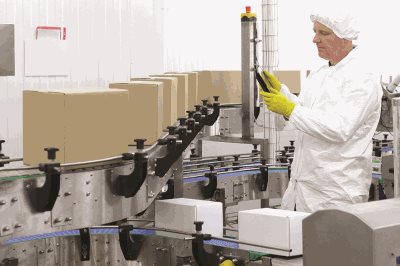Manual data collection is alive and well in modern manufacturing. But in this age of electronic data in which we find ourselves, it’s shocking that so many manufacturers have yet to make the move from paper to electronic records. Up to 75 percent! While it may seem cheaper to manually administer quality and safety programs on paper, it is by no means efficient…and it tends to leave too much room for error.
Manufacturers need to consider a range of factors as they move to handle records electronically. However, the change provides an array of advantages when compared with manual data collection methods. Paper records can be lost or misplaced, data can be illegibly entered and error-prone, making it difficult to retrieve accurate information—all of this ultimately results in costly delays, lost business opportunities, and frustrated plant staff. So, it’s not surprising that in some industries—food and beverage, pharmaceutical, and medical device—electronicrecord keeping is required by the Food & Drug Administration (FDA) 21 CFR Part 11.
In order to remain compliant and ensure product safety for consumers, manufacturers must properly manage documents and records on monitoring traceability and recalls, providing corrective and preventive action (CAPA), and handling food safety audit requirements. The obvious answer, in my opinion, is for manufacturers to move to the cloud and begin storing quality data digitally. This change offers manufacturers many benefits that just aren’t available in a paper-based system.
Move from Paper to Electronic
Moving from paper to electronic must begin with data collection. It’s the first thing manufacturers mention when they talk about their paper-based systems. We’ve delved into this topic on many occasions here at InfinityQS, most notably in blog articles from COO Doug Fair, VP of Global Marketing Greg Matranga, and Director of Global Channel Programs Jason Chester. The overriding theme, as you may have guessed, is that a move from paper to electronic—what we sometimes call “digital transformation,” is not just good for your modern manufacturing business, but it’s becoming a necessity as well.
To prevent being left behind, you need to make the paper-to-electronic conversion. You need to reap the benefits of real-time data and analysis, as well as rid yourself of the limitations of paper in the manufacturing world.
Greg mentions in his blog that “paper, spreadsheets, the old way of doing things—that’s passé. It’s time has come and gone. Paper, specifically, is very expensive and incredibly inefficient. We can’t expect that people are going to be able to write perfect numbers and letters; much of the data capture we’ve seen is written on paper for quality systems—written by very busy operators, and oftentimes it is unintelligible. It can’t even be interpreted. Even the guesses we make are no good.”

Doug states that it’s “hard to change old paper-based habits.” But that doesn’t stop him from trying to disrupt the status quo. “Regardless, I believe that using paper is the invisible dinosaur that lurks in modern manufacturing sites, creating panic, chaos, and havoc when information and reports are required by managers and customers. Using paper is expensive, archaic, and the source of lots of shop floor issues.” I’m detecting a theme here!
And, lastly, Jason sees the problem at its core, and tries to get down to the basics, when he says, “quality never rests. If you produce goods that are sub-par, consumers will not buy them and if they do, they won’t buy them again. If you ship goods that are unsafe or in breach of regulations, the authorities will soon be knocking at your door.”
So, the first step in your transformation journey should be electronically collecting data. You reduce errors, catch problems early, save time and money, and—in the long run—hang onto your customers by producing consistently high-quality goods.
Difference Between Paper vs Electronic in Manufacturing
“First, humans are imperfect,” says Doug. “Writing things down on paper inevitably results in illegible content, transposed numbers, faked data (sadly, it does happen), and other issues.” Paper is quite simply a highly fallible system. Electronic information is, and always will be, right there at the click of a mouse for you to view. In this regard, there is a clear winner in the paper vs. electronic record keeping argument. No digging through file systems, or warehouses, for the information you need…when you need them.
“Yes, technology is the obvious solution,” says Greg. “But our experience shows that most manufacturers are very slow adopters of technology…because they think that new technology is really expensive. But the answer is it’s not—especially cloud technologies.”

So, there’s the major argument against going digital: it’s expensive. But when you factor in things like the cost of maintaining your burgeoning library of paper documentation, the cost in manpower when you have to assign key individuals to research and cull that paper-based information for audit purposes, the very real advantage that real-time alarms provide to prevent sub-standard products (as well as excess scrap and dreaded recalls), and the declining cost of cloud technology, it just doesn’t add up. Moving to a digital solution—from paper to electronic—will end up saving you money. In my opinion, that’s the key difference.
Paper vs Electronic Record Keeping
Record keeping, as far back as we can see, has always been a paper-based activity. Seems to me that the comfort in using a time-worn technique is enough for some people. But if you have paper records, you invariably have a person assigned to maintain and manage that library.
Doug, in particular, has experience with dealing with organizations that insist on using paper: “I’ve seen companies manage paper in a variety of ways. I’ve even visited companies that employ on-site librarians just to manage the production-based paper that’s generated every day at their facilities. Some organizations use so much paper that they need a separate warehouse just to store it all. The bottom line: paper is expensive and time-consuming.” He has a point there. Seems counter-productive to rely on paper, doesn’t it?

I tried to think of all the users that need to access the data that you might keep on paper: operators, quality people, managers. They often need to review what’s been preserved on paper. And it just doesn’t work. When storing data electronically, organizations gain many benefits, including:
- Everyone who needs to see information can do so with a click
- That data can easily be compared to other, perhaps similar, data to draw conclusions about a process or a machine
- Your data can be associated with any aspect of your process you want, like control limits or spec limits
Doug expounds on this: “Papers often do not have specification limits written on them. That makes it difficult for an operator to assess whether the data they’ve just recorded is good or bad. Instead, it’s just a data collection exercise. That can be frustrating for operators.” So, for your operators’ sanity…convert to digital.

Why Handle Data Electronically?
Jason’s blog, which talks about reasons for digital transformation, pretty much sums up the five most important factors to be considered when thinking about handling data electronically. And they are:
- “Do More With Less for Efficient Manufacturing – In the face of a disruption, demand for your product may dry up or skyrocket overnight.
- Be More Agile and Responsive – Adapt to volatility and uncertainty on both the demand and supply sides of your manufacturing organization.
- Quality Never Rests – No matter the circumstances, if you produce goods that are sub-par, consumers will not buy them and if they do, they won’t buy them again.
- Tribal Knowledge is a High-Risk Strategy – Knowledge that has been gained on the plant floor is locked in the heads of the people who have garnered all that experience. When these valuable workers leave, your productivity, perhaps even your entire business, is threatened.
- Remote Work is the New Reality – We must find a way to give people access to the data, the analytics, and all the information they need without putting them at risk.”
Paper to Electronic Conversion in 3 Steps
1.Standardizing
Standardization makes everything easier when it comes to every aspect of your quality management efforts: collecting, analyzing, and reporting on your quality data…and it makes everything more powerful.
And centralizing your quality data is the easiest way to standardize. Standardizing naming conventions (product codes, feature names, lot number formats, etc.) is crucial to bringing order to your manufacturing efforts. Not only does it ensure a common code of communication across all plants, but it supports system-to-system integration, and enables simplified high-level reporting and data analysis across all plants.
When naming conventions are standardized, your quality management system can easily aggregate data across production lines and plants, providing corporate-wide quality insights that are generally impossible to uncover without standardization.

2.Select the Cloud
Deciding on an implementation architecture for your data collection software is a critical factor. If it’s necessary to get up and running quickly with minimal internal IT commitment or structure, then a cloud solution is in order. But if there’s already a robust and well-maintained infrastructure in place, then perhaps an on-premises solution would be preferable.
Also consider ongoing maintenance and upkeep. Will IT staff be available to maintain upgrades and licensing, or would it be beneficial for the software provider to handle that in the cloud? With the cloud, time-consuming and costly “upgrades” become easy, painless, behind-the-scenes “updates” handled by the software vendor.
And cost is always a concern. Cloud solutions offer a recurring subscription expense and on-premises deployments often require updated technical infrastructure. But, if you carefully calculate all software expenses, as my colleague Brad Forrest has done in this blog series, you’ll have a better understanding of which deployment option is right for your organization.

3.Instill Positive Change
Finally, the last hurdle in every company-wide change will be to ensure that everyone is using the software properly and taking full advantage of its features and functionality. That is no different when it comes to the paper-to-electronic conversion of data collection and record keeping.
Never assume that because there is a change, everyone will know how to adjust. Every employee must know the proper standards and protocol to make your move to digital a seamless effort. Creating a culture of quality and instilling proper change management initiatives smooths the way to full usage and benefit.
Our quality experts recommend that manufacturers start small and then expand iteratively. This agile approach allows your operators, quality professionals, and managers to gradually become more comfortable with the software system and how it may change the way staff members think about their new digital world.
Once managers and operators truly understand the power they have at their fingertips, they will begin to modify their approach to gathering and entering quality data into the system. This iterative approach can also be less disruptive to overall manufacturing operations and the individual users, reducing the impact of the change.